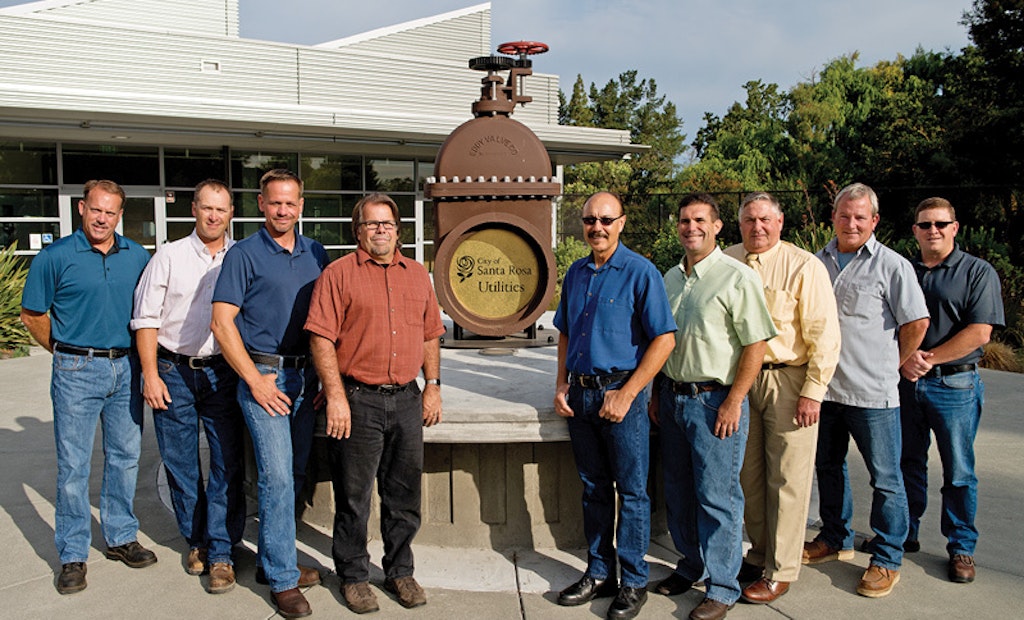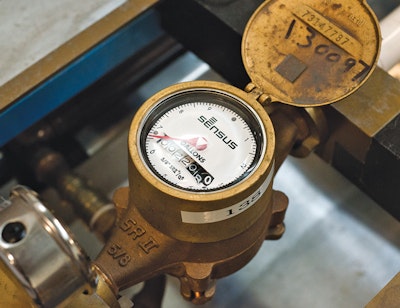
Interested in Stormwater?
Get Stormwater articles, news and videos right in your inbox! Sign up now.
Stormwater + Get AlertsThe goal of the City of Santa Rosa Utilities Department is to maximize resources (water, biosolids, digester gas and nutrients) while striving to eliminate service interruptions and customer complaints from among its 53,000-plus residential and commercial accounts.
Under normal flow control conditions, the department recycles 100 percent of its treated wastewater, either to the innovative Geyser geothermal project north of the city (see sidebar) or to storage ponds that irrigate over 6,500 acres at local dairies, vineyards, lawns, golf courses and parks. The department is working diligently to replace the remaining old clay pipe in its wastewater collection system. And from Department Director David Guhin down through all employees, customer service is number one.
The department is also coping successfully with a shrinking budget.
“The economic downturn hit us just as hard as everyone,” explains Mark Powell, deputy department director for Local Utility Operations. “We’ve had to cut positions and lay off some employees. But our objective has been to keep up a reasonable level of service despite shrinking staff and budgets.”
He adds that new technology, equipment, processes and employee empowerment have enabled the department to accomplish required levels of work despite new environmental regulations, which are among the strictest in the region.
Origins
In 1985, Santa Rosa experienced a major discharge of secondary treated wastewater to a local waterway. The community — located in the heart of California’s environmentally conscious north coast — responded by forming the Santa Rosa Utilities Department, upgrading to entire tertiary treatment at its Subregional Wastewater Reclamation Facility (Laguna Treatment Plant), and committing to reuse as much as possible.
“The goal,” says Powell, “was to become close to 100 percent reuse, and avoid any kind of a major discharge again.”
Today, the department serves over 168,000 residential customers and numerous commercial and other service types including some residents in the county’s unincorporated areas. A system of 589 miles of sewer pipes and 17 lift stations collects wastewater and delivers it to the Subregional Laguna Treatment Plant and Reclamation system, which accepts about 21 million gallons a day from a total of 215,000 customers.
Each of the subregional partners in the Laguna Treatment Plant — Santa Rosa, Rohnert Park, Sebastopol, Cotati and the South Park County Sanitation District — is responsible for its own collection system.
The Laguna Treatment Plant includes biological treatment, tertiary filtration and UV disinfection.
Biosolids are digested, dewatered and either sent directly to an indoor composting facility, stored indoors for composting or used for land application.
Following treatment, the water is pumped directly to the Geysers Recharge Project or to the storage ponds for local irrigation.
“When the department was formed in 1985, the goal was to improve wastewater treatment to the point that we could be 100 percent reuse, with a high quality product that could offset potable irrigation water and other uses,” explains Powell.
“Zero discharge is the goal,” he says, adding that in 2010 and 2011 there were some discharges due to heavy rains, while 2009, 2012 and 2013 have been discharge free.
He explains that typically, 60 percent of the plant’s dewatered biosolids are land-applied, with the remainder used for composting. Very little goes to landfill.
Digester gas fuels generators that produce about one quarter of the treatment plant’s dry weather electrical needs. Solar panels located on some of the department’s buildings and properties generate another 466 kW of electricity.
A diligent environmental compliance section within the department supports the wastewater collection system and Laguna Treatment Plant. Area restaurants and businesses are all under permit and have regular inspections to prevent toxic releases and the buildup of fats, oils and grease (FOG) or other products. The department’s environmental compliance division also initiated an over-the-counter and prescription drug take-back program that has collected around 19 tons of pills since 2008. Powell calls the program “outstanding.”
Pipe problems
While the department has taken advantage of numerous cutting edge technologies and management practices, its sewer system needs updating. Powell explains that over 40 miles of the city’s sewer lines are constructed of clay pipe — some of it 60-80 years old. The system as a whole has 46 miles of main exceeding its estimated service life (50 years), although some has been shown to be in excellent physical condition.
“We started replacing it several years ago,” Powell explains, noting that the department would like to replace 1 to 2 percent of the entire older system every year. “It’s a range of sizes [4 to 66 inches] and materials. A lot of the joints and pipe are old, but age is only one criteria used for recommended replacement.
“Hydraulic deficiency, grade, risk, maintenance frequency and CCTV inspection results all play a part in replacement decisions,” he adds.
Santa Rosa is using a variety of replacement methods, including cut and cover, cured-in-place pipe (CIPP), pipe bursting and sliplining. CIPP is usually the department’s choice for larger pipe diameters.
“The department’s employees do the smaller pipe repairs, patching and pipe bursting jobs in-house, and contract out the larger projects,” says Powell. “No one method is good for every application.”
To maintain their systems, the department has a fleet of four combination cleaning trucks, an easement machine, one mechanical rodding truck and two CCTV camera trucks on the street every day along with their repair crews with three hydroexcavators and backhoes. They also use chemical root control. The objective is to televise and clean all pipes 36-inches in diameter and smaller within five years or less.
Crews also smoke test the collection system to identify inflow and infiltration and illegal connections. The goal is to smoke test the entire collection system at least once every seven years.
Staffing
In order to have a well-trained and balanced staff, the department practices cross-training by rotating the utility system’s grade I and II operators annually. The operators spend one year in a collections system section, then rotate into the water distribution section of the division.
“Our cross-trained utility system senior operators and the system supervisors remain in their sections to maintain continuity and provide additional training,” explains Powell. “There are also two fully experienced and cross-trained superintendents who have been promoted within the organization and have full expertise in both our water and sewer systems.”
In addition to variety, Powell says the approach gives the crew members better opportunities for future advancement. “They are well diversified, experienced and able to protect customers and the department in most emergencies,” he says.
Santa Rosa takes the same approach with staffing schedules. “We use a 9-80 workweek,” says Powell, explaining that crew members work nine-hour days, 80 hours in any two-week period (eight-hour Fridays). “Half the division works four days and has one Friday off while the other half has the following Friday off.
“We also have a dedicated weekend crew which works Wednesday through Sunday. This way we have seven-days-a-week coverage for nine hours a day, and the staff here can do just about anything water or wastewater related wherever they’re needed.
“The entire department works as a team,” he says, adding that communication (face-to-face, emails or a simple phone call) is the key to success.
As a minimum, all of the local water/wastewater division’s utility systems managers and operators are required to be licensed by the California Department of Public Health as water distribution operators. Some employees have water treatment certification and all are required to have a California Water Environment Association (CWEA) Collection System Maintenance certificate for wastewater. All operators are also required to maintain a California Class A commercial driver’s license.
Asset management
A better handle on asset information has helped Santa Rosa clean, repair or replace its water, wastewater and reclamation systems, as well as equipment at the treatment plant.
“We started implementing an asset management system 14 years ago,” explains Powell. “Getting or sharing correct up-to-date information was a problem before. Now we’re getting much better information, much faster, and have a better work order system.
“Our local division has reduced overflows through better and faster information, tracking and improved cleaning,” he explains.
“In the ’70s and ’80s, there might have been four backups, spills or overflows a week. We’ve had only one this year, three last year, and only one the prior year,” Powell says. “It’s a significant improvement.”
The department employs a dedicated team to manage the data and coordinate with operations, and the capital improvement and engineering groups. “The team tracks every asset pipe, valve, pump, etc., which helps to manage our budgets,” Powell says.
“Every TV image and log goes into the system,” he continues. “Anyone can pull up that information, look at hot spots, check anything that looks abnormal and keep an eye on FOG and pretreatment issues.”
As a result, commercial and industrial customers have been very cooperative.
Customer service
“Customer service is number one from the top down and the bottom up,” Powell says. “It starts with the phone call or contact to our Utilities Administrative Service Center (UASC), and ends with the team’s response to our customers, external as well as internal.
“It’s understood throughout the department and from each employee’s first day that customer service is our number one goal.”
Actions back up the statements. “Our employees are at your house responding to a call within a half hour during regular work hours, and by our standby employee within an hour after the regular work day ends,” Powell says.
No matter if it’s a backed-up or broken sewer or water line or a failed shut-off valve on a residence, the Santa Rosa team responds. “Good or bad, we try to go over and above customer expectations,” Powell says. “It’s instilled in our employees during training.”
Budget battles
Foreclosed homes and shuttered businesses resulting from the recent recession have reduced revenue to water and sewer departments like Santa Rosa.
Nonetheless, says Powell, the department has been able to maintain a high level of service because of its dedicated employees — especially the financial/budget section — plus the use of new technologies, even as tightening regulations have actually raised the cost of collecting, treating and recycling treated wastewater.
Santa Rosa has had to lay off staff, but has successfully compensated by adopting technology that has enabled the department’s employees to accomplish most of the work with fewer people. Better equipment, smartphones, laptop computers, automated meter reading and updated SCADA systems are some of the tools being used.
Prioritization has been the other key. “We are making do by prioritizing,” says Powell, noting that the most significant and cost-effective projects are the ones that are done first.
“We could spend millions on capital improvement projects right now,” he says. Instead, the department has phased and prioritized its CIP every year as funds allow, averaging about $11.3 million in just sewer collection system projects each year.
“Our biggest challenges are new and changing regulations, shrinking budgets, employee retention and succession planning,” concludes Powell.
“Our employees are our most important asset and vital to the public health, safety and the welfare of all our community. Without them, and the support of our city manager, Board of Public Utilities, City Council and our rate payers, we would not or cannot be successful.”










